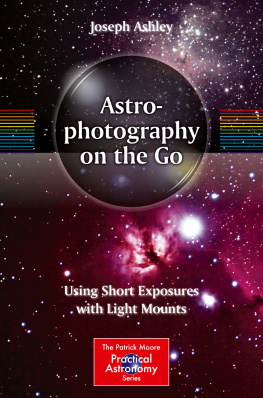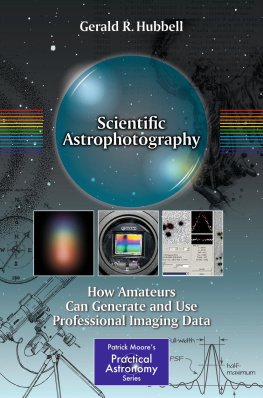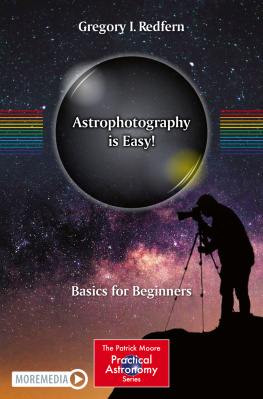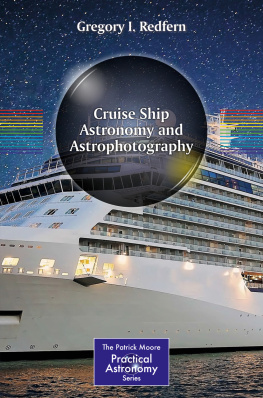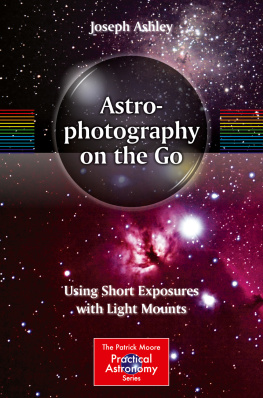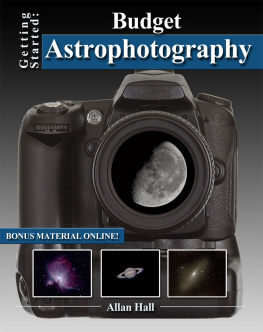1.1 Introduction
Do you live in a city and think you cant do astronomy, much less astrophotography, with your light polluted gray night sky or do you believe astronomy is impossible because you have no way to transport, store, or use a large telescope at your home? Perhaps you simply prefer small and lightweight telescopes or maybe physical constraints prevent you from using heavy traditional astrophotography gear. Have you ever wished your astrophotography kit could fly with you on a vacation and arrive in one piece at your destination? Maybe you simply want to take snapshots of what you see in your telescope to share with family and friends. If any of these scenarios fit or if you are simply just curious; welcome to the world of very short exposure astrophotography with light weight mounts; welcome to the world of Astrophotography on the Go.
Astrophotography on the Go is lean and mean. Its purpose is not to replace the traditional heavy German equatorial mount but to take astrophotography to places where heavy, bulky telescopes cannot go or are not welcomed. Its ultimate objective is to bring astronomy and astrophotography to the millions of people on this planet living in urban settings who have never seen the wonders of our universe.
Whether you are a beginner to astronomy or an experienced observer just now starting down the road to photograph the Milky Way, Astrophotography on the Go, is appropriate for you. The photographic processes described are applicable for all alt-azimuth and equatorial goto mounts, however, the emphasis is on compact, lightweight, portable mounts and tripods weighing less than 16.5 lb (7.5 kg). Extraneous equipment, like a computer, is not welcome and must remain at home. One philosophy describes the tone of this book: If you cant carry your entire kit including your observing chair in one trip from its storage spot at your home to your observation site and back, it may be movable but it is not lightweight or portable.
1.2 Technology Considerations
Until recent times, amateur astrophotography was the exclusive providence of a very few dedicated astronomers with the fortitude and patience to sit hours on end staring at a guide star while imaging some distant deep space object. Then the digital revolution hit astronomy and changed everything; first with affordable computerized telescope mounts and more recently with the digital single lens reflex camera. Today, images that were only dreams of yesterday are routinely made by amateurs around the world using moderately priced equipment. Some even use entry level telescopes and mounts and make images that easily rival or surpass the best of the film days and often compete with images made with advanced level methods and equipment.
Today we live in a world of continuous technology advances. Early in the twenty-first century, digital imaging technology advanced to the point where digital single lens reflex (DSLR) cameras were available at affordable prices to the general public. Not only were digital cameras affordable, they had sufficient resolution and sensitivity to photograph faint objects located in deep space.
The development of the affordable digital camera was a paradigm shift for amateur astronomers. With digital technology, photographers could digitally combine several exposures into one image that was in many respects the equivalent of one longer exposure. This capability had a dramatic impact upon astrophotography. A photograph requiring hours and a very dark sky to capture with one exposure using a film camera could be duplicated by combining several shorter digital exposures. A passing jet plane or satellite no longer meant disaster that ruined a nights worth of work. Amateur astronomers worldwide readily embraced the digital camera and in a very short time were producing digital photographs that rivaled images produced by major professional observatories.
Parallel with the development of digital imaging technology was another digital revolution; computerized telescope mount technology that could automatically point a telescope at any selected object in the sky. These mounts were introduced to amateur astronomy in the early 1990s and became known as GOTO mounts or GOTO telescopes. The accuracy and tracking capabilities of these GOTO mounts rapidly improved and their prices dropped. Initially GOTO technology was limited to the premium telescope lines but during the first decade of the twenty-first century, the technology spread across the spectrum of amateur telescopes from beginner telescopes to those used by the most advanced amateur.
GOTO telescopes and digital cameras are a natural for astrophotography. Being digital devices both can connect to a personal computer. This allows computers to perform many of the chores associated with astrophotography that were previously done by hand. No longer is the astronomer glued to a chair for hours meticulously guiding a telescope keeping a star centered in a reticle eyepiece. Computers and automatic guiding routines do that task. These attributes and others married the telescope to personal computers.
Initially, photo-processing programs were used to digitally combine several short exposure images into an image equivalent to a longer exposure. This was done by meticulously aligning and combining each exposure one by one; a time consuming process called stacking. As digital astrophotography became more popular, several computer programs, commercial and freeware, became available that automated this stacking process. The development of digital stacking programs created another revolution for astrophotography. Now, instead of a few images literally hundreds of exposures could easily be digitally combined.
At the same time, amateurs realized that the tracking abilities of modern equatorial GOTO mounts that were precisely polar aligned were sufficient to obtain exposures of several minutes duration without needing guidance. This development combined with digital stacking programs gave birth to unguided astrophotography which is very popular today. This is especially true for people just starting astrophotography or who live in areas impacted by light pollution where long exposures are not possible.
However, two attributes of this digital revolution for astronomy are not fully appreciated by the astrophotography community at this time. These are:
The sensitivity and internal noise characteristics of modern digital cameras are sufficient to capture images of a large number of deep space objects using very short exposures of 30 s or less and to do so with an usable signal to noise ratio even with relatively slow telescopes.
No longer is a mount and supporting tripod or pier required that is vibration and movement free for long periods of time. All that is needed is a mount that can consistently provide short periods of stability while it tracks an object. This requirement is within the capabilities of many relatively inexpensive, lightweight GOTO azimuth and equatorial mounts used today with entry level telescopes.
These three developmentsaffordable digital single lens reflex cameras, computer stacking software, and computerized GOTO mountsset the stage for a third category of astrophotography; very short exposure astrophotography using inexpensive, compact, lightweight GOTO mounts. Very little information, printed in books or cyberspace, is available regarding the techniques needed for very short exposure astrophotography using lightweight mounts. Astrophotography on the Go consolidates current knowledge related to astrophotography using very short exposures and lightweight GOTO mounts and is based upon personal experiences over a period of several years.

